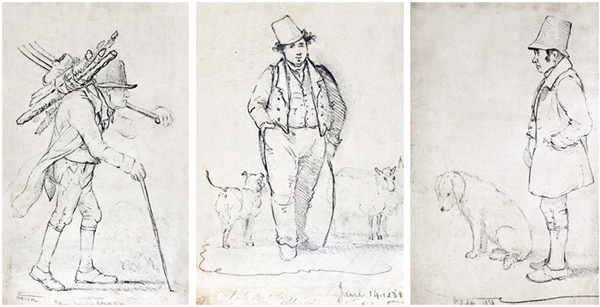As you cross the Trent, you are very much aware that you have moved from the south to the north country. The next great divide is the Tyne, with the dramatic straggle of Newcastle stretching east and west. Beyond lies mile upon mile of Northumberland, all the way to the Scottish border, arable land for grazing (punctuated with coal mines) by the coast, giving way to heathery moors and countless sheep. The centre of this often wild and always beautiful land is Alnwick, with roads stretching out, to north and south the Great North Road, east to the fishing port of Alnmouth, westward to the Roman Wall and the Cheviots.
Alnwick Castle was the centre of the defence against invaders from the north, seat of the Percy family, Earls and Dukes of Northumberland. There, about 1831, a local artist, Percy Forster, set himself the unusual task of depicting the inhabitants of the town and country round, exactly as they were, on the eve of the Reform Bill.There are 117 pictures in all, mostly full-length profiles in pen and ink, preserved in a large book that has descended to Professor Middlemas from his grandfather, a solicitor at Alnwick. Put together, they form a speaking portrait, not merely of the people but the society of this northernmost English town, just before it changed into the Victorian era.
In 2009 the British Museum put on ‘Intimate Portraits’, an exhibition of drawings from Ramsay to Lawrence, the century before Forster set to work. They were all of individuals; so are Forster’s, but they are also types, like Gillray or Dighton’s similar profiles. Besides particular people, ‘Billy Carr, long postmaster at Alnwick’, here are farmer, sexton, merchant, farrier, miller, the Duke’s woodsman, huntsman and shepherd (wrapped in plaid), the earth-stopper and the poacher, and George Barkas the schoolmaster — ‘I was taught at his school,’ wrote Forster, ‘and never knew a better man.’ In one way they are uniform; they wear frock-coat or cutaway, most the tall hat that had superseded the cocked hat and not yet grown to the Victorian top-hat. But from these frames emerge very individual faces, characteristically Northumbrian features, still recognisable today.
Most of the figures are men. The few women, ‘Mrs Dodds, a good and religious woman’, ‘Morrison’s Pills’ counted by an older woman, Forster’s younger sister, hair brushed back from the nape in the height of fashion, are clearly characters as well as types; ‘Old Molly Todd, long hostess at Coal Eglingham’ is every inch the landlady. Unlike the men, often done ‘from memory’, as they had to be, since recorded in the same year, the women seem more often to be done from life. The children certainly are, caught in the act with hoops or marbles. One little boy has a duck under one arm, a string of kippers slung on the other. Dogs are clearly portraits too, as vivid if not more so than their masters. Fishermen with rods (Alnwick had other makers besides the famous Hardy’s) are set against other fishermen, come ashore at Alnmouth, still in sou’westers and ‘sea-burnt’ boots.
‘I put it aside,’ writes Middlemas of the book he inherited, ‘but over the years the portraits crept upon me like Pirandello’s Six Characters in Search of an Author.’ They have now found him. As professor of history at Sussex, he specialised in modern political economy. The knowledge of history’s broader issues thus acquired has now found a new outlet. All his dramatis personae find a place in a play set against a backcloth of medieval and later Alnwick. An economy where age-old crafts and means of earning a living is beginning to give way to new industries.Banks are coming in, literacy is growing, religious tenets are shifting, and the ‘view from Alnwick’ is stretching out. Once limited by the Borders and the Tyne, it is looking further abroad, whither Darwin has just set off in the Beagle.
Nearer home, the impact of Reform is stirring, while three excellent local Northumbrian historians, Davison, Hodgson and Mackenzie, are recording the more distant past. But here, caught in the footlights, are Billy Smith ‘corn factor at the Star Inn, reading reports of the markets’, cocky Mr Clark the butcher, hat on the side of his head, with dog and sheep, and ‘Old Peg Downson age 81 went round the country… selling oranges, nuts, gooseberries in the season’, and many others, all ready to tell us who ‘they really were’ all but 200 years ago.





Comments